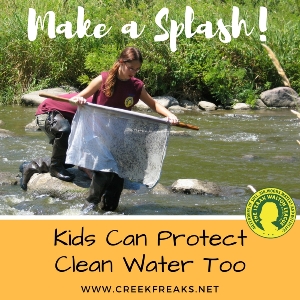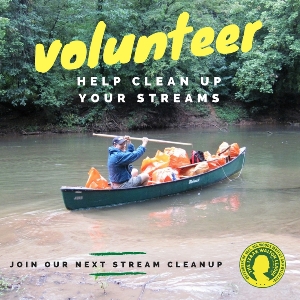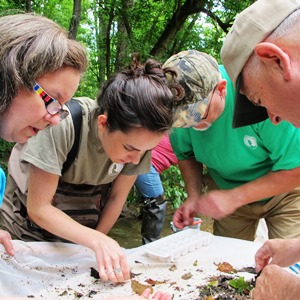Ways To Get Involved
We developed a range of ways to get involved with the
Clean Water Challenge to match every age and level of interest. If your idea of enjoying the outdoors is a backyard barbecue, a quick
Stream Selfie might be right up your alley. If you want to make a big difference with a simple project, consider a stream clean-up. If you can commit a little more time and don’t mind getting your feet wet, you could be a new stream monitor!
League staff created new resources to help League members and chapters in these efforts. Resources in the
Clean Water Challenge “Getting Started” Toolkit can be used immediately as-is or customized to fit chapter needs. The toolkit was handed out to attendees at our 2017 national convention and mailed to every chapter president and
Save Our Streams coordinator who could not attend convention. After convention, we also e-mailed a link to the toolkit to every League member for whom we have an e-mail address. You can
download individual resources or access the full kit on the League's website.
Stream Selfies
We are asking every League member to take a photo by a stream they care about, answer a few questions, and post the photo to our national map of stream sites. For stream sites being monitored today, the Stream Selfie map will provide a powerful visual representation of the impact volunteers have in communities nationwide. This
map will also provide a national inventory of streams that could be monitored in the future by League members and citizen volunteers.
Put your favorite stream – or one you’re worried about – on the map. Encourage your fellow chapter members, friends, families, and community to get involved as well. Taking photos with streams is a great way to engage people in the outdoors.
Visit
Stream Selfie for tips and more details.
Resources for Chapters – Materials in the
Challenge toolkit related to individual Stream Selfies include
handouts, sample content, and graphics to be used on websites, in newsletters, and on social media channels.
Anyone can take a Stream Selfie – and hundreds of people have posted their selfies on our nationwide map, individually and in groups. Some chapters are already exploring the use of Stream Selfie as a promotional tool to engage the local community. Stream Selfies can also be a fun group activity!
Selfie Walks

Consider hosting a community “Selfie Walk.” The walk could begin or end on chapter grounds (if applicable) and introduce the community to the Izaak Walton League and everything your chapter has to offer (stream sites included).
Selfie Walks also offer opportunities to develop local partnerships. For example, your chapter could invite a naturalist to talk about local plants and animals during a stream walk or someone from the Historical Society to speak about how local streams and rivers shaped the history of your town.
Resources for Chapters – The League
developed tools to promote and leverage Selfie Walks, including media alerts and press releases, sample content, and graphics to be used on websites, in newsletters, and on social media channels.
Stream Clean-Ups

League members are working with other volunteers across the country to clean up streams in their communities. Stream clean-ups provide an easy way to get the community – including young people and families – involved in the Clean Water Challenge and make them aware of the great work your chapter is doing!
Clean-ups are about more than making communities look good. Taking trash out of streams also helps keep local waters healthy. When trash accumulates in streams and rivers, it can damage fish habitat, block out sunlight vital to underwater plants, and deplete oxygen in the water (which all aquatic animals need to survive). Plastic pollution breaks apart in water and releases toxins into your waterways, and fish and wildlife can die from mistakenly eating plastics and other trash. Sharing information about the damage caused by trash in streams can increase interest in clean-ups among potential volunteers – and the media. One way chapters can use local Stream Selfies is to identify target locations for stream clean-ups.
Stream clean-ups offer a great starting point for potential corporate partnerships. Companies in your community may encourage their employees to volunteer for projects. Look to local stores not only for cash donations to support your efforts but also material donations (gloves, bags, safety vests) and employee volunteers.
Resources for Chapters – Resources in the
Challenge toolkit to help promote chapter stream clean-ups include media alerts and press releases, sample content, and graphics to be used on websites, in newsletters, and on social media channels, and tips on using the Chapter Accomplishment tool (see below).
Publicizing clean-up results is just as important as promoting the event beforehand. The League created an online Chapter Accomplishments tool (login required) to help chapters track their accomplishments and cumulative results, including for stream clean-ups. This information will be helpful for local media coverage and grant applications as well as engaging chapter and community members. Click the Officer Tools tab at the top of the League website to access this resource. These results also allow the national organization to add up chapter totals for a picture of our national impact. Chapter results are the “raw material” needed to raise the League’s visibility through national press releases and other communications. If you have questions about using the online Chapter Accomplishments tool, e-mail
members@iwla.org.
Need tips for starting a stream clean-up? The
IWLA Chapter Manual offers guidance on this activity and more. (Login is required to access the electronic file.)
Local Partnerships
Other groups in your community share the League’s passion for clean water and citizen-led conservation efforts. Every partnership begins with an initial meeting. A great place to start is organizations your chapter is already working with, such as community and faith-based organizations, local watershed associations, Scout troops, or a canoeing club.
Involving the local community is critical to the success of any volunteer stream monitoring effort, especially as the League works to expand the number of stream sites monitored across the country. It is important to not only share information about potential water quality issues with partners but also to get feedback on why community members care about specific waterways.
Resources for Chapters – To help chapters promote the Clean Water Challenge to other community organizations, the
toolkit includes fact sheets, Clean Water Challenge logos, tips and tactics for reaching out to potential partners, as well as graphics to be used on websites, in newsletters, and on social media channels.
Stream Monitoring
 The League was founded by sportsmen concerned about water pollution and its impact on the outdoor pursuits they loved. Since that day in 1922, clean water has remained a priority for our organization.
The League was founded by sportsmen concerned about water pollution and its impact on the outdoor pursuits they loved. Since that day in 1922, clean water has remained a priority for our organization.
The League was one of the first groups to recognize that with the right tools and training, any citizen can collect scientifically valid information about water quality. For almost 50 years, the League’s Save Our Streams (SOS) program has helped volunteers assess and report water quality conditions in local creeks and streams, making it one of the most successful citizen science programs in the country.
Volunteers do not need a background in science or expensive equipment to be successful stream monitors, and monitoring can involve as little as 16 hours of your time over the course of the year. While the time commitment is small, the impact is huge! Volunteers can provide important information about the health of waterways to state and local agencies, neighbors, and the media. Volunteer groups can also use this information to plan restoration projects, track changes in stream health over time, and advocate locally to improve and protect water quality.
Volunteer stream monitors can evaluate four different aspects of stream health:
- Biological: Aquatic macroinvertebrates live on, under, and around rocks and sediment on the bottoms of rivers and streams. They vary widely in their tolerance for pollution, so the presence – or absence – of certain macroinvertebrates can tell monitors whether or not a stream is healthy. The League’s Aqua Bugs app can help monitors accurately identify the macroinvertebrates they find.
- Chemical: Testing the chemical components of a stream – including pH, dissolved oxygen, and nutrients – provides a good sense of overall water quality. It is also valuable in pinpointing specific areas of concern, such as nitrogen runoff from farm fields and suburban lawns.
- Physical: Information about the physical characteristics of a stream – such as erosion, stream bank vegetation, and algae growth – provides clues about possible sources of water quality issues.
- Flow: The amount of water running through a stream plays a factor in water quality. Tracking flow rates gives stream monitors more information about changes in runoff over time.
Resources for Chapters – The Clean Water Challenge toolkit includes targeting resources to help chapters succeed with stream monitoring, including stream monitoring instructions, Aqua Bugs flier, media alerts and press releases, Save Our Streams logo and graphics to be used on websites, in newsletters, and on social media channels.
You can also
find stream monitoring video tutorials, data forms and instructions, equipment lists, and tips for beginning stream monitors on the League website.
Volunteers using other protocols to monitor stream health can also add new sites to our 100,000 Clean Water Challenge goal. This effort is not limited to the League’s Save Our Streams program.
Sharing Results
Publicizing results after an event is just as important as promoting the event ahead of time. In addition, the national organization can use local results from chapters across the country help raise the visibility of the League nationally. Here’s where you can share your successes:
- Share Selfie Walk results by e-mailing details and group photos to sos@iwla.org.
- Track stream clean-up totals using the Chapter Accomplishments tool, which allows you to keep running totals of trash collected and volunteers engaged. You can find this resource in the Officer Tools section of the League website.
- Enter your stream monitoring data into the Save Our Streams national database.
- Share solutions to local pollution problems you discovered through stream monitoring. Your successes will encourage new stream monitors. E-mail details and photos to sos@iwla.org.
Resources for Chapters – The
Clean Water Challenge toolkit can help you share results locally and includes press releases, instructions on how to upload stream monitoring data, tips on the Chapter's Accomplishments tool, and graphics to be used on websites, in newsletters, and on social media channels.